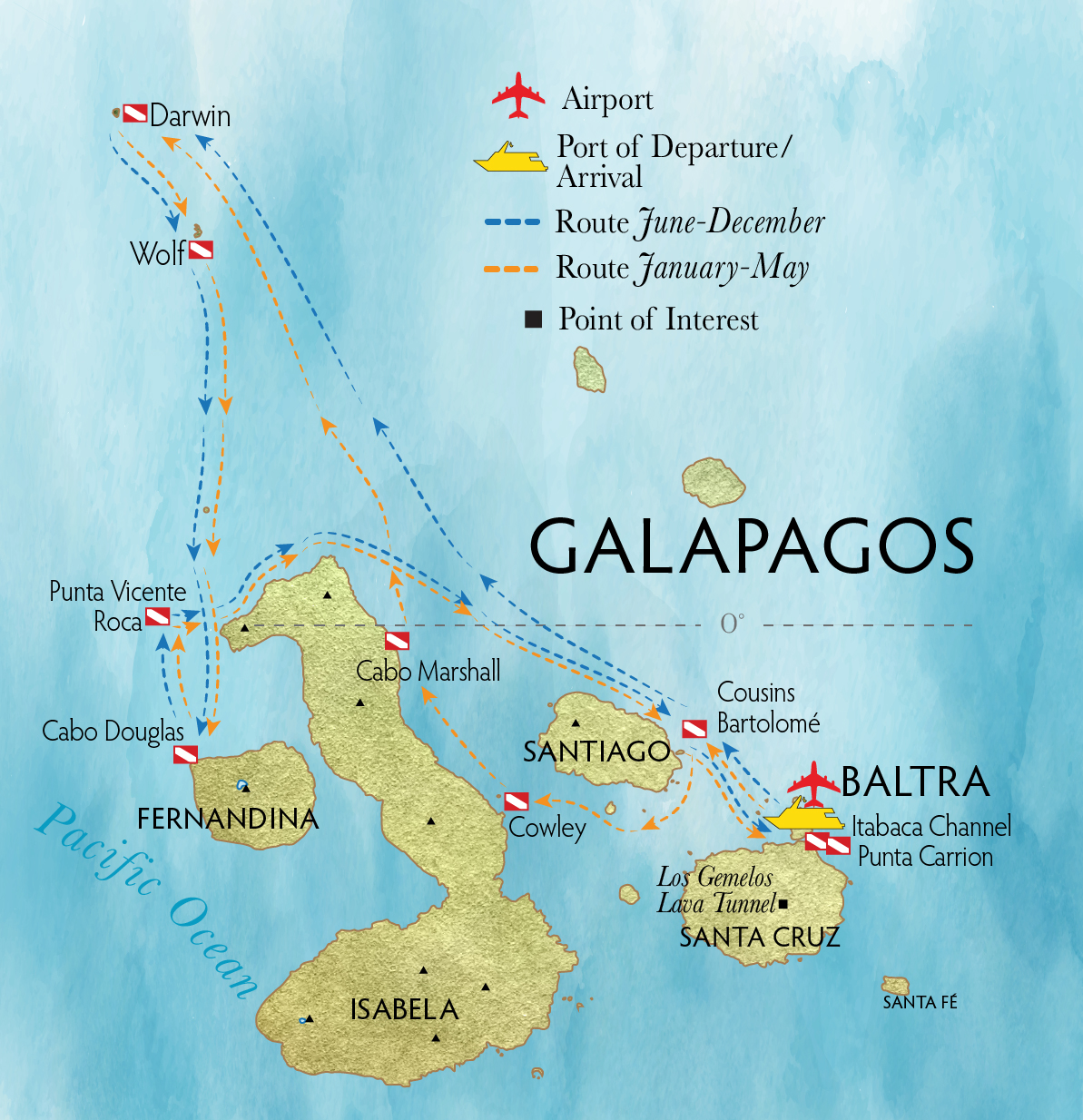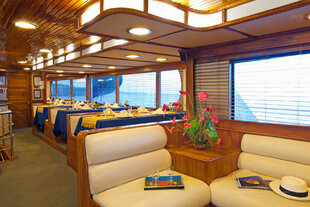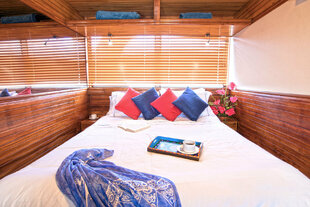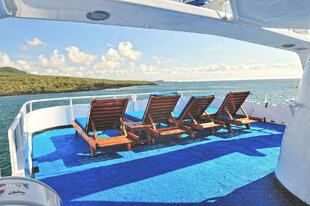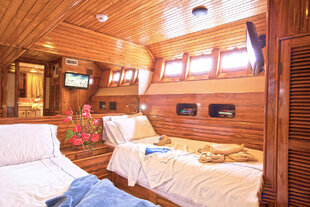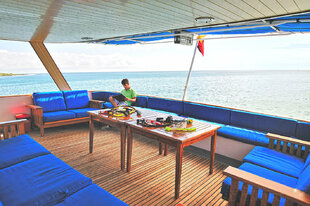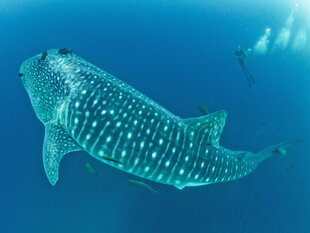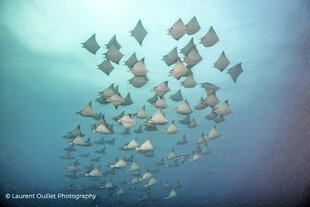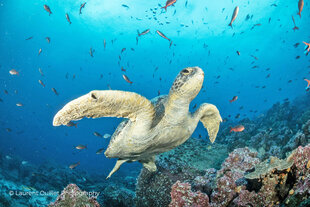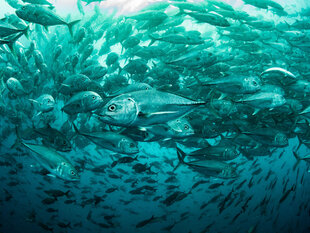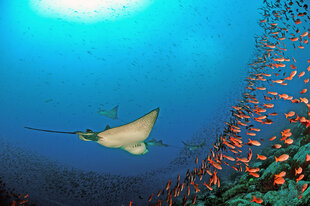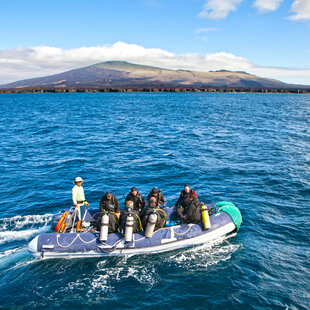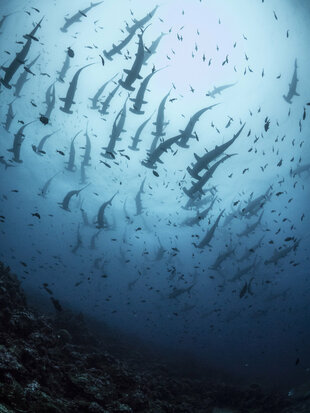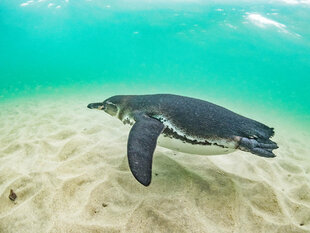Aggressor III is a dive liveaboard yacht with 4 decks. There are 4 deluxe staterooms on the lower deck, each with twin beds, and 4 master staterooms on the upper deck, each with a queen bed which can be changed into twin beds, giving the boat a capacity of 16 guests. Aggressor III comes with many spaces for relaxation during your journey: the main deck has a restaurant and lounge; the upper deck has an open-air lounge and there is a sun deck with a shaded cocktail area and hot tub. Presentations are given onboard by crew and guides regarding fish identification and other topics related to the Galapagos and conservation.

The cuisine onboard will be varied, plentiful and can accommodate any dietary requirements (you must give advanced notification). Breakfasts feature a selection of fruits, juices and cereal accompanied by a hot meal. Lunches will either be a hot soup, sandwiches or entrees. Dinners are 3 course meals prepared by the chef every evening, including salads, vegetables, seafood, beef or chicken with a freshly made desert.
Solo travellers can share a twin room with another of the same gender to avoid single supplement.
Air tanks (K valve), weights, belts, all food onboard, non-alcoholic drinks, local beer & wine and airport transfers are included in the price.
Not included: masks, fins, snorkels, BCs, regulator system, dive computer.
Diving, Wildlife & Photography
The primary focus of the trips offered on this boat is diving with marine life in the Galapagos. You will be swimming in the waters of Wolf and Darwin Islands, known for their abundance of sharks like Hammerheads and White-Tips – even Whale Sharks in the right season. It is also common to see Turtles, schools of Tuna, Eagle Rays and Sealions.
There are plenty of opportunities for underwater photographers on these itineraries, not only for marine life already mentioned, but also of complex and unique underwater rock formations. There are great subjects for macro photographers, with opportunities for shots of Sea Horses, Barnacle Blennies and Coral Hawkfish among others.
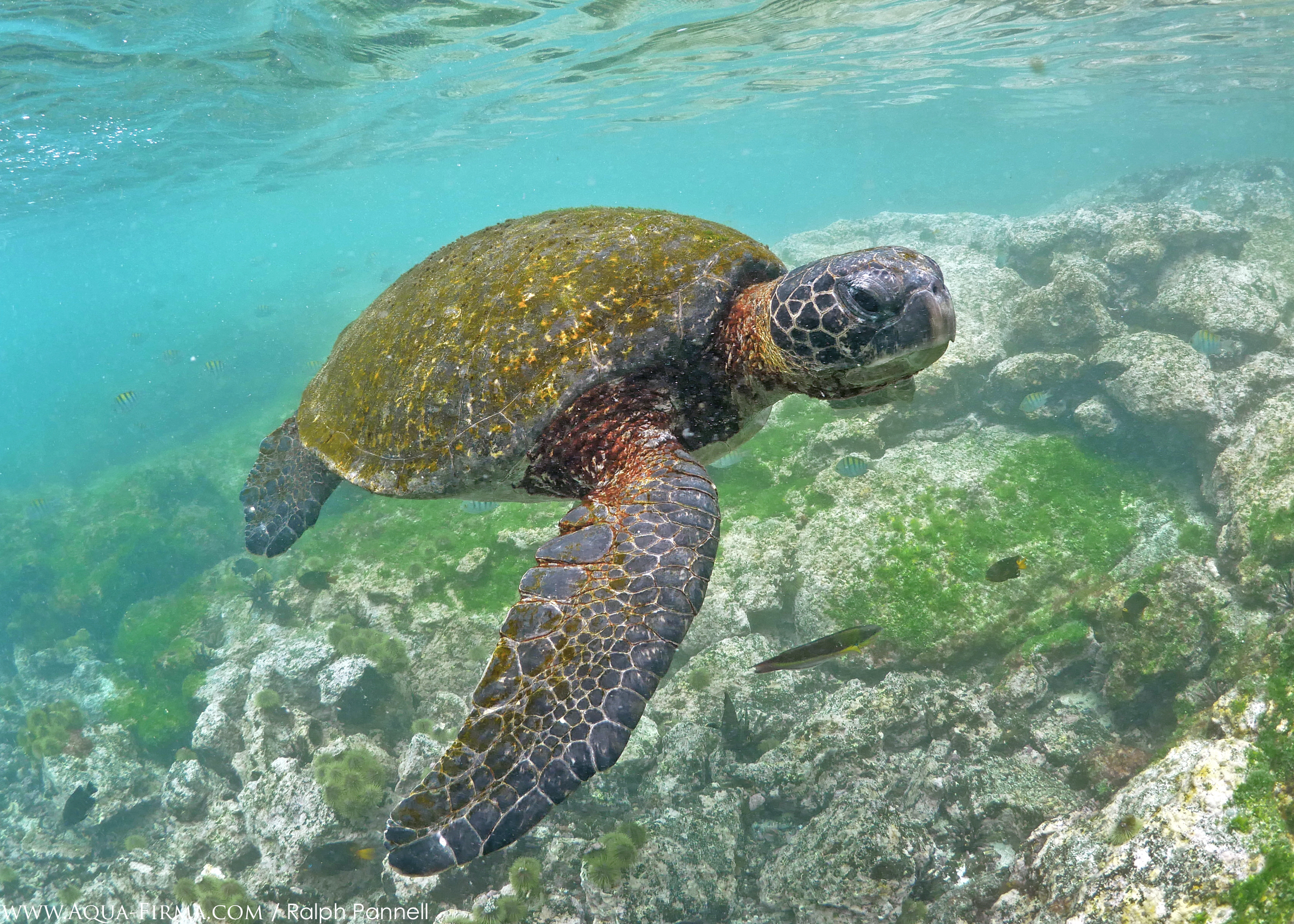
Although the diving in the Galapagos gives a brilliant experience of the archipelago, there are many opportunities to explore more of the islands above the water. This ship does include some activities above water but if you would like to explore more of the Galapagos Islands through land-based excursions, you could consider adding more time to your stay by choosing an add-on experience from our Galapagos page.
Technical Specifications
| Length | 100 ft / 30.5 m |
| Beam | 22 ft / 6.7 m |
| Passengers | 16 in 9 cabins |
| Cabins | 4 master staterooms on upper deck & 4 deluxe cabins on lower deck |
| Staff | 10 |
| Social areas |
Salon |
Deck Plan
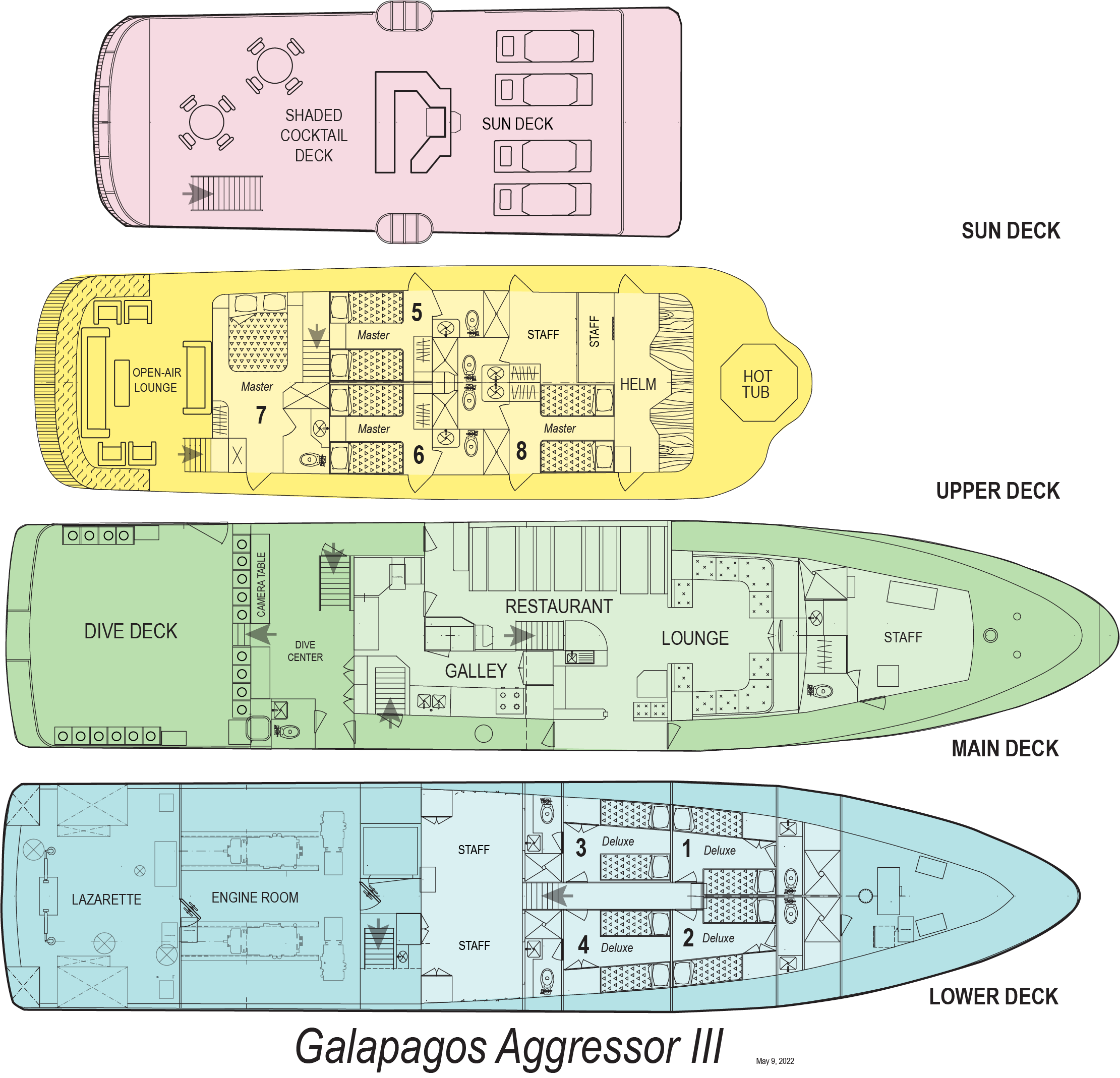
Itinerary
Please note that these itineraries are subject to change without notice due to seasonal changes, last minute weather conditions and the decision of the Galapagos National Park authority.
Day 1 (Thursday) – Arrival & Orientation Dive
AM: Arrival, Baltra Island
Upon arrival Baltra, you will pass through an airport inspection point to make sure that no foreign plants or animals are introduced to the islands, and to pay the park entrance fee of $200 (unless it has been prepaid). A guide will meet you, help you collect your luggage and escort you on a short bus ride to the harbour.
PM: Orientation Dive, Santa Cruz Island
You will make sure that your diving gear is fully functional and comfortable on an orientation dive at Punta Carrion so that necessary changes can be made before beginning the main part of the dive cruise.
Day 2 (Friday) – Morning Dives & Bartolomé / Pinnacle Rock
AM: Punta Carrion, Santa Cruz Island
Punta Carrion has a rock wall which provides dozens of hiding places for White-Tip Reef Sharks and Stingrays to hide. Inside this wall lies a calm bay with an overhang where we might find sharks resting on the white sand. Other marine life here includes Eagle and Marbled Rays, Scorpion Fish, Sea Turtles and Sea Lions.
PM: Isla Bartolomé & Pinnacle Rock, Bartolomé Island
After diving, you will hike on Bartholomé. Although at first sight lifeless, Bartolomé offers some of the wildest landscapes and best panoramas of the entire archipelago. To enjoy the postcard view of the idyllic Pinnacle Bay, you have to climb steps to a viewpoint on top of the island (114 m / 375 ft). Enter a dramatic world of threatening (though extinguished) nearby spatter cones, craters, and lightweight lava droplets that have been spewed out by fiery fountains. The Summit Trail is also ideal for witnessing how scanty pioneer vegetation such as lava cacti manage to take root on the bare virgin lava fields.
You will also get a panga ride around Pinnacle Rock this afternoon. Pinnacle rock is a volcanic plug, an island which was created in the vent of a volcano. Although now largely eroded, Pinnacle Rock is home to many unique species of liken and houses a Galapagos Penguin colony at the foot of the rock.
Day 3 (Saturday)
January to May
AM: Roca Blanca Island, Isabela Island
This island, particularly under the radar for the Galapagos, is home to some of the best diving you can hope to experience in the central islands of the archipelago.
With the interaction of currents within the archipelago having an unusual effect on this location, water temperatures here are brought down, and the amount of nutrients are brought up.
Taking advantage of these conditions are huge schools of fish, and with these come abundant predators. You can hope to see bait balls writhe and flash as Billfish and Hammerhead Sharks slice through them in dramatic feeding frenzies. This site is sometimes home to as many as 6 shark species and has been known to be a spot where you can see Manta Rays, too.
With 2 morning dives here, you can hope for some great sightings here to kick-off your day.
PM: Cowley Island & Cabo Marshall, Isabela Island
Starting off your afternoon is a dive at one of the more popular dive sites in the Galapagos – Cowley Islet. This is home to a brilliant array of endemic marine life.
Galapagos Sea Lions, Penguins and Cormorants can be found in plentiful abundance here at times, accompanied by an armada of other fantastic species like Stingrays and Manta Rays, Sharks and Sea Turtles.
As you explore the islet underwater, you can glide past incredible sponge and coral formations, home to endless marine microfauna – great for underwater macro photographers.
Following this afternoon will be a dive at Cabo Marshall.
Cape Marshall in on the north-east side of Isabela and is home to a few great diving spots. In these dive locations, it is easiest to drift dive across a black coral-coated vertical wall descending to the seabed where Hammerhead, White-Tipped & Galapagos sharks can be spotted. Even Whale Sharks have been seen here. Other marine life includes large schools of Black-Striped Salema and Barracuda.
June to December – Darwin Island
During this time period, you will have 2 morning and 2 afternoon dives at sites around Darwin Island.
Darwin Island is a high relatively flat-topped island which is impossible to land on since it is sheer cliff all around. Thousands of birds live on the island, including Nazca Boobies and Frigate Birds. In addition to the island, Darwin's Pillars (formerly an arch) is a dramatic feature offshore; and many of your dives will be close to this point. Again, it is impossible to land here safely, but there is a colony of sealions which you will see from a distance living beneath the Arch.
The marine life is usually spectacular here with many sharks, especially hammerheads, which can swim very close. There are also lots of Porites coral bommies, so please avoid touching these. Between June and October / November, you will have good chances of seeing whale sharks here, including some huge females measuring up to about 15 metres.
Arco de Darwin
Darwin’s Arch, now a pillar formation since the arch collapsed in 2021, is one of the Galapagos’ most iconic locations. The shallow reef platforms around the landmark make this a great diving spot for seeing schools of Scalloped Hammerheads. Whale Sharks can also be seen here, mostly between June and November, with females making a stop-off during their solitary migrations.
Darwin’s Theatre
This dive site is where two forked ridges pointing northeast and southeast from the reef foundation of Darwin’s Arch. Curved shelves bending around the northern branch give the appearance of a grandstand with panoramic hangouts at around 18 m / 60 ft, giving the dive site its name. There is often swarming marine life here, with Hammerhead, Requiem and Silky Sharks, Yellow-Fin Tuna, Wahoos, Bonitos, Amberjacks and large schools of fish often being common sights here.
El Arenal
This dive site brings you close to the cleaning stations of Darwin Island, where Sharks, Turtles and Jacks regularly visit to be freed from parasites by the resident Barber Fish and King Angelfish. The busiest area here is the sandy slope in front of El Arenal portal. When the surge isn’t too strong, being dropped off here allows you to come face-to-face with Scalloped Hammerheads and resting Pacific Green and Hawksbill Turtles. As you swim further out, you can see the sloping shelves of rubble dropping into a deep gully, with the upper edges offering hideouts for Hammerheads. Other highlights here, depending on the season, include Whale Sharks, Bottlenose Dolphins, Mobula and Devil Rays and Giant Oceanic Mantas.
Day 4 (Sunday)
January to May – Wolf Island
During these months, you will have 4 dives at dive sites off Wolf Island.
Wolf Island is one of our planet’s most incredible dive locations. It is actually made up of two volcanic islands with a sheltered bay which you might share with a Sea Shepherd monitoring boat.
This is a good spot to see Red-Lipped Batfish which 'walk' along the seabed.
Wolf Island itself is one of the best places in the world to dive amongst sharks. This includes schooling hammerheads, Galapagos sharks, silky sharks, white tip sharks amongst the cliffs and caverns and sometimes whale sharks. Spotted eagle rays are another delight here and huge numbers of fish filling the water.
Anchorage
Anchorage is the only dive site located on the west coast of Wolf Island. Here, the strange walking Red-Lipped Batfish can be seen 20 m (70 ft) deep on the seabed. Though this animal is mainly active at night and is attracted by your diving lights, this probably won’t be your only time seeing it.
La Banana
La Banana, also known as North Islet, has a sheer wall whose shape resembles that of a banana and is dotted with caverns, tunnels and other interesting rock formations. This dive site normally has great visibility and equally good marine life, with highlights including Galapagos Sharks, Hammerheads, Manta Rays and Green Turtles.
La Ventana Islets
At La Ventana Islet (Window Islet in English), there is diverse marine life. One of the biggest highlights here is the Red-Lipped Batfish, which walk around on the sea floor. Hiding in and swimming around the complex rock formations are many other sea creatures, such as Moray Eels, Barracuda, Dolphins, White-Tip Sharks and Hammerheads. Whale Sharks can even be seen here between May and November.
Shark Bay
Shark Bay is on the east side of Wolf Island and is shallower than most other sites around it but one of the most memorable due to high Whale Shark traffic which gave the site its name. There are also local cleaning stations here where you can see visiting Hawksbill & Pacific Green Turtles.
The Landslide
This is one of the best dive sites of Wolf Island, with hundreds of Hammerhead Sharks circling around or heading against the current in some seasons. This drift diving site follows a boulder slope underneath the partly collapsed east cliffs of the islet leading to a hangout between the boulders where you can see Requiem Sharks, pelagic schools. In hotter seasons, Pacific Green Turtles, Spotted Eagle Rays and, sometimes, Mobula Devil Rays and Giant Oceanic Mantas can be seen here too.
The Pinnacle and the Caves
At this site are some of the archipelago’s most interesting caves. Located north of Wolf Island, there are 4 main caves which penetrate the pinnacle, normally easily accessible with cave entrances at 15-21 m (50-70 ft). A sandy ledge runs along the wall beneath the entrances to each cave, where it is possible to see Hawksbill and Green Turtles gathering, schools of Soldierfish, Guineafowl Puffers, Moray Eels, Whitetop Reef Sharks, Marble Rays, Cardinalfish and Lobsters. If you have time, the cave with the largest opening can be interesting to explore. The dive here ends in the northeast corner of Wolf at a large underwater pinnacle ending just below the water’s surface. If the currents allow, you can hold on to the pinnacle and watch the marine life visible from it.
The Secret Cave
This dive site was formed by the collapse of large gas chambers dating back to the formation of Wolf. Along the walls which are sometimes surrounded by Hammerheads, there is an entrance to a cave with several nocturnal species like Cardinalfish, Spiny Lobsters, Shrimp, Sea Urchins, hunting Moral Eels, Pacific Green Turtles and Sea Lions.
June to December
AM: Darwin Island
You will have 2 morning dives around Darwin Island during these months.
Dive sites you may visit include those listed in Day 3.
PM: Wolf Island
You will have 2 afternoon dives around Wolf Island – dive sites you may visit include those listed above.
Day 5 (Monday)
January to May
AM: Darwin Island
There will be 2 morning dives at Darwin Island.
PM: Wolf Island
There will be 2 afternoon dives at Wolf Island.
June to December – Wolf Island
There will be 4 dives at Wolf Island today – 2 in the morning and 2 in the afternoon.
Day 6 (Tuesday) – Cape Douglas & Vicente Roca Point
AM: Cabo Douglas, Isabela Island
There is some great wildlife to see at Cape Douglas, including Flightless Cormorants, Galapagos Penguins and Marine Iguanas. Beneath the waves you can hope to see Red-Lipped Batfish, Galapagos Bullhead Sharks and Mola-Mola. It is sometimes possible to see baleen whales at this site too. Diving here should be great for Marine Iguana encounters, as well as underwater volcanic formations.
PM: Punta Vicente Roca, Isabela Island
There are great underwater opportunities at Vicente Roca Point thanks to upwelling cold-water currents here. Marine life in the area includes various shark species, Galapagos Penguins, Seahorses & Mola-Mola. Other animals which you can hope to see here are Nazca & Blue-Footed Boobies, Brown Pelicans & Flightless Cormorants. A Panga ride after your dive will give you the site’s best opportunities for photographing Galapagos Penguins, Flightless Cormorants and Blue Footed Boobies.
Day 7 (Wednesday) – Cousin’s Rock & Highlands / Fausto Llerena
AM: Cousin’s Rock, Santiago Island
Cousin’s Rock dive site is characterised by its sloping rock formation which is home to many reef-dwelling marine animals such as Seahorses, Octopus, Sharks, Sea Lions and Green Turtles. You will have a morning dive here.
PM: Highlands & Fausto Llerena Breeding Centre, Santa Cruz Island
After lunch, you will go on a bus tour to the Highlands of Santa Cruz. The road to the highlands leaves from Bellavista, a small village located a 15-minute drive from Santa Cruz’ main town of Puerto Ayora. The road passes through the Galapagos’ most productive agricultural zone, up to the National Park boundary. We find Miconia vegetation at this altitude, changing to the Fern and Sedge zone as we ascend further. With clear weather, we can enjoy beautiful scenes of rolling hills and extinct volcanic cones covered with grass and lush greenery all year round. In the Highlands, you will be able to see Galapagos Giant Tortoises as they graze in freshwater ponds and there will be a diversity of birdlife rarely found in the lowlands.
You will also visit Fausto Llerena Breeding Centre, which was founded in 1965 with the aim of rescuing Pinzón tortoises from extinction & was previously home to Lonesome George – the last of the Pinta Island Tortoises – who died in 2012. The Galapagos Tortoises currently at the centre are accustomed to humans, so there are great opportunities to get photos of these amazing creatures.
You will be able to eat dinner at a local restaurant of your choice this evening, but this meal is not included in the price of the trip.
Day 8 (Thursday) – Departure
AM: Departure, Baltra Island
Breakfast will be followed by checkout and transferral to Baltra airport. Your guide & some crew members will go with you to Baltra where you will board the airport shuttle. Your guide will remain with you through the check-in counters & departure hall.
Dates
There is a $200 discount for non-divers on this trip.
Children below 10 years old cannot travel on this itinerary.
Under 18s are eligible for a 25% discount but must travel with an adult parent.
Under 18s who wish to stay in a stateroom with another guest need parental permission. When a room is occupied by 2 children, parents must be in an adjacent room.
Included
Accommodation onboard
Diving activities, compressed air tanks, weights & belts
All meals & snacks, non-alcoholic drinks, local beer & wine
Airport transfers
Excluded
Galapagos National Park entrance fee ($200)
Galapagos Visitor’s Card ($20)
International & domestic airfares
Travel or dive insurance
Nitrox fills, certification or speciality courses
Hotel stays / day rooms
Dinner on final evening
Tips & gratuities
Port / park fees, fuel surcharges & local taxes
Single Supplement
A single supplement rate of 65% on the full rate is added to the price of a private room. For group departure dates, single supplements must be assigned 90 days prior to departure date.

